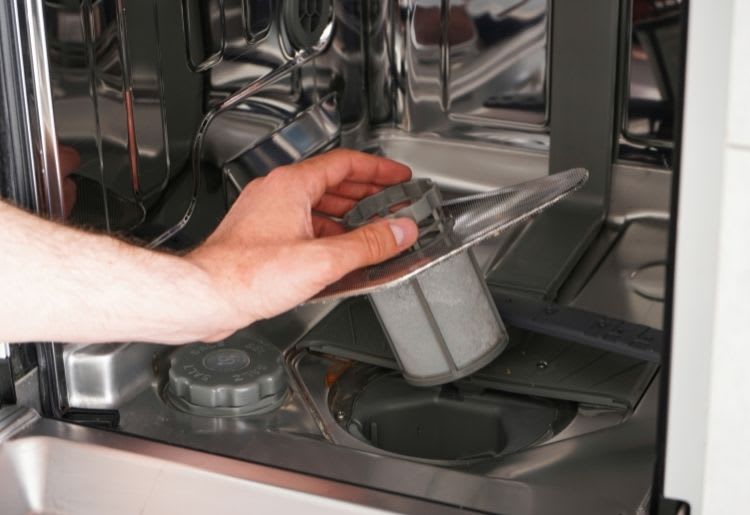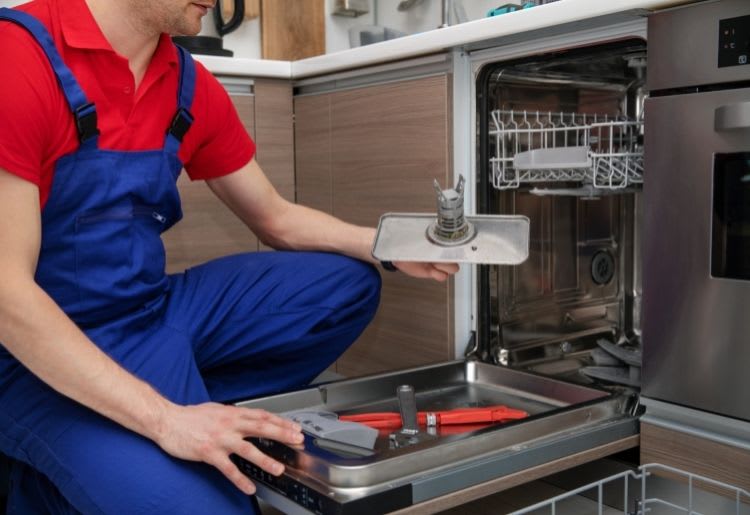While having a home warranty plan can provide you with financial protection if your dishwasher breaks, regularly cleaning your filter can also help keep your appliance in good working order.
So, we’ve put together a simple step-by-step guide explaining the best way to clean your filter and how to spot the signs that your machine may be at risk of becoming clogged.
What does a dishwasher filter do?
The purpose of a dishwasher filter is to stop small, wet pieces of leftover food from sticking to your dishes and ultimately clogging up your drain.
If you don’t get around to cleaning the dishwasher filter on a regular basis, pieces of stuck-on food from your dishes will end up caught in filter. Not only will this cause your machine to be less efficient, but it could also result in dirty water building up in the machine—water that could harbor germs and bacteria.
When do you need to clean your dishwasher filter?
Although some experts recommend cleaning your filter every week, others argue that it is only necessary to do so once every few months. However, it goes without saying that the more often you run your dishwasher, the more frequently you’ll need to clean the filter.
If you scrape and pre-rinse your dishes before putting them in the dishwasher, your filter will probably need cleaning less frequently, although it is sensible to get into the habit of cleaning it on a regular basis.
Here are some telltale signs that it may be time to clean your filter.
Visible food particles in the filter
Dishes not being fully clean after a cycle
Dishes that feel gritty after having been washed
Unpleasant smells coming from your dishwasher
Water not draining correctly
In addition to regular deep cleans, it’s a good idea to remove any visible pieces of debris and leftover food from your dishwasher as soon as you spot them. This should be done after each cycle and should only take a couple of seconds.
Is your dishwasher filter manual or self-cleaning?
Before you attempt to clean your dishwasher filter, you’ll first need to know which type of filter you have: manual or self-cleaning.
Older dishwasher models (pre-2010) typically have self-cleaning filters, while newer models normally require you to clean the filter yourself. Although self-cleaning might be the kind of feature you’d expect to see in newer appliances, having a self-cleaning filter typically made the dishwasher extremely noisy.
If you’re not sure which type of filter your dishwasher has, you should be able to find this information in your appliance’s manual. Alternatively, you’ll normally be able to find the answer online by searching for your appliance’s make and model.

How to clean your dishwasher filter
Although cleaning your dishwasher filter sounds like a tedious task, the good news is that it typically takes just a couple of minutes if you follow these simple steps.
A pre-cleaning checklist
Before you clean your filter, it will help if you have the following.
Rubber gloves
An old toothbrush
A flashlight
A copy of your dishwasher’s manual
Dish soap or a sponge
1. Locate the filter
In most cases, the filter will be on the floor of your dishwasher, which means you’ll need to remove the bottom dish rack to access it.
Your filter should resemble a cylindrical tube. Depending on your dishwasher make and model, the filter may have two parts: an upper and lower filter. The lower filter will resemble a flat piece that sits beneath the upper filter.
While identifying your filter should be relatively straightforward, it will help if you have a flashlight to hand to more easily see in dim spaces.
2. Remove the filter
In many cases, you can remove your filter by twisting it off and pulling on it gently. Although this is often in a clockwise direction, many dishwashers have arrows on their components to indicate the direction in which you need to twist the filter.
If your dishwasher has a lower filter, you’ll normally find that this isn’t locked in place and you can remove it by simply lifting it up.
3. Place the filters under a running tap
The easiest way to clean your filter is to place it under running water and remove any visible debris and pieces of food. If your filter is particularly dirty or covered in limescale, you may also need to use dish soap or a sponge.
Try using a small brush to gently scrub the inside of the filter, which should also remove bits of food trapped inside the filter. Avoid using anything abrasive, like wire brushes, as this risks damaging the filter.
4. Lock the filter back in place
Once you’ve cleaned the filter, return it to your dishwasher and lock it back in place. To do so, you need to turn the filter in the opposite direction than the one you used to unlock it.
Remember to check that the filter is firmly secured, as running your dishwasher with a loose filter could cause serious damage to your appliance and may invalidate your warranty.
5. Clean the rest of your dishwasher
If you’ve decided to clean your filter, you may as well take the opportunity to bring the rest of your machine up to scratch.
In addition to polishing your machine’s exterior, you should check for any nasty surprises lurking in crevices such as the interior of the door and control panels. Try using an old toothbrush to scrub any grime or residue from your dishwasher’s rubber seal.
As a word of warning, you should never use bleach to clean a dishwasher that is made of stainless steel, as this could damage your appliance. If you’re not certain whether you can use bleach on your dishwasher, check the manual and air on the side of caution.
As an added precaution, always ensure you’re wearing rubber gloves when cleaning your dishwasher.
What about self-cleaning filters?
If you have a self-cleaning filter, you may think that you don’t need to do anything to keep your appliance sparkling clean. However, machines with self-cleaning filters also need an occasional refresh to remove unpleasant odors or excess grime.
Many home maintenance and DIY experts recommend using white vinegar to clean these types of dishwasher filters. This technique involves placing a cup of white vinegar inside your dishwasher in a dishwasher-safe container and running your appliance on a hot-water cycle.
Another technique is sprinkling baking soda into the bottom of the dishwasher before running a short cycle on hot. About a cup should do the trick.
Will my home warranty cover my dishwasher?
Although regularly cleaning your filter can help improve the efficiency of your dishwasher, no appliance lasts forever, and Consumer Reports estimates that the average dishwasher has a lifespan of approximately 10 years.
If you would struggle to cover the cost of repairing or replacing your dishwasher, consider taking out a home warranty plan.
Should your dishwasher break down, your home warranty company can arrange for a tradesperson to perform an inspection. The expert can then advise you whether it can be repaired. If your dishwasher is beyond repair, your home warranty provider should cover the costs of replacing your device, although you'll normally need to pay a fee service on every claim you make.
Although most policies should include coverage for your dishwasher, you should check the terms and conditions of any potential policies before you commit yourself. This way, you can ensure you have all the protection you need.
When you’re buying a home warranty plan for homeowners, it’s also wise to check for the coverage limit on all appliances, including your dishwasher. Although it’s tempting to choose a home warranty plan with lower monthly premiums, these will normally also include lower payout limits per item.
If you’d like to find a home warranty plan that will protect your dishwasher, consider a policy with Choice Home Warranty or First American Home Warranty, as these both offer affordable and comprehensive coverage.
Note that if your dishwasher leaks and causes damage to your property, your homeowners insurance should cover the cost of repairs to your belongings.
If you’d like to learn more about household maintenance, check out our articles How to Increase the Lifespan of 10 Common Household Appliances and Top 10 Home Maintenance Skills Every Homeowner Should Master.
Conclusion
While having your dishwasher malfunction or break down can be extremely frustrating, you can boost its performance and avoid that possibility by carrying out regular maintenance such as cleaning your filter. And if you’re still concerned about the potential costs of repairing or replacing a defective dishwasher, taking out a home warranty plan can provide you with additional peace of mind.
